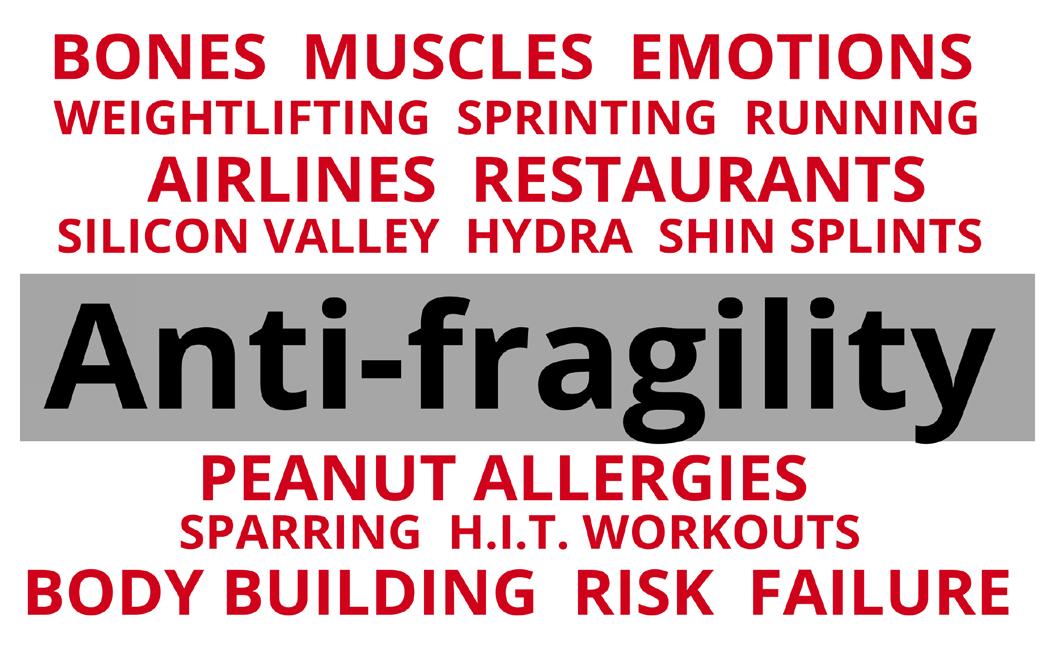
2 minute read
Making Everyone Safe From Any Stressor May Just Be Un-Safe In Itself
Maddox Rosenberg Image Editor
Antifragility is defined as a property of systems in which they increase in capability to thrive as a result of stressors, shocks, volatility, noise, mistakes, faults, attacks, or failures. Our bones and muscles are antifragile. More stress equals the more durability and strength. This principle can also be applied to feeling and emotions.
The term was coined by author Nassim Nicholas Taleb in his book titled Antifragile. He gives some examples of antifragility: “The phenomenon is well studied in medicine, where for example Wolff’s law describes how bones grow stronger due to external load. Hormesis is an example of mild antifragility, where the stressor is a poisonous substance and the antifragile becomes better overall from a small dose of the stressor. This is different from robustness or resilience in that the antifragile system improves with, not withstand, stressors, where the stressors are neither too large nor small.”
The larger point, according to Taleb, is that depriving systems of vital stressors is not necessarily a good thing and can be downright harmful to its ability to overcome and thrive.
For example, astronauts while in space for large stretches of time reported a decrease in bone density. Without gravity pulling and pounding on their bodies, their bones did not have to work as hard. This phenomenon, though, applies to more than just the physical body.
The old saying: “Sticks and stones may break my bones but words shall never hurt me,” first appeared according in a book called Eothen in 1830.
“The rhyme is used as a defense against name-calling and verbal bullying, intended to increase resiliency, avoid physical retaliation and to remain calm and good-living”(Wikipedia).
Emotions are antifragile. The more “abuse” one takes, the less it affects that person. But nowadays, society is told to never hurt people’s feelings because it will result in harm to them. This is opposite to the antifragility model and mindset.
Because of the decreased resistance people are taking to their feelings, the more and more sensitive people are becoming. It is the same principle as the astronauts that lose density in their bones after not experiencing gravity for a while; the less emotions are pushed, the less one can take.
In an article published by the CDC, they state that “bullying can result in physical injury, social and emotional distress, selfharm, and even death. It also increases the risk for depression, anxiety, sleep difficulties, lower academic achievement, and dropping out of school.” It goes on to claim that“youth who bully others are at increased risk for substance misuse, academic problems, and experiencing violence later in adolescence and adulthood. Youth who bully others and are bullied themselves suffer the most serious consequences and are at greater risk for mental health and behavioral problems.”
Obviously, bullying in its full form is not the answer to the fragility problem because of the genuine harm it causes kids. But, to overcome the weakness that is prevalent in all aspects of American culture right now, people must be less focused on whether someone’s feelings might be hurt when interacting with each other. Emotions and feelings are antifragile, but the less they are tested, the easier feelings can be hurt.
To step away from the fragile world, we as a society need to be a little more honest to each other. In order to get back to a world where “words will never hurt [us],” society must embrace the anti-fragility model when interacting with one another to build a resistance to extreme sensitivity and cancel culture.










